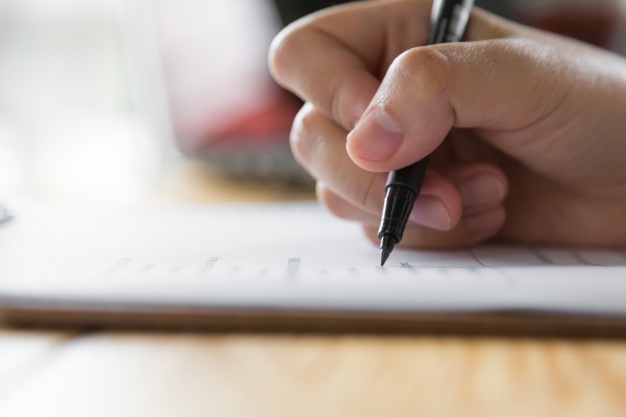5 Symbols of Pancasila as the National Emblem, Along with Their Meanings and History
These are the 5 symbols of Pancasila as the national emblem, along with their meanings and history. Let's check it out, KLovers.

Kapanlagi.com - Writing is the most enjoyable thing to do. In writing, there is certainly a good text. In a text, the presence of paragraphs is very important. A paragraph is a collection of sentences consisting of a main sentence and explanatory sentences. Supporting sentences function as explanations of the main idea. That is why paragraphs are the most important part and element in written works and literature.
Generally, paragraphs begin with a new line and contain one main idea and interconnected ideas. Usually, a paragraph is marked by an indented first line. In addition, the characteristics of a paragraph are that each paragraph uses one core or topic sentence and other sentences as developing sentences that function to explain, describe, or clarify the main idea in the topic sentence.
Now, to help increase your knowledge, here are some explanations about the types of paragraphs that you need to know. Let's take a look at the following review.

(credit: freepik)
-Deductive Paragraph, is a type of paragraph that has the main sentence located at the beginning of the paragraph. Basically, this paragraph starts with a general statement, then followed by specific explanations. These explanations can be examples, specific details, evidence, and so on.
-Inductive Paragraph, is a type of paragraph that has the opposite definition of a deductive paragraph. This type of paragraph has the main sentence at the end of the paragraph. Inductive paragraphs start by presenting explanations and end with a topic sentence. Inductive paragraphs can be divided into three types: generalization, analogy, and causality.
-Mixed Paragraph, is a type of paragraph that has the main sentence at the beginning and end of the paragraph. This type of paragraph starts by stating the main issue, followed by explanatory sentences, and ends with the main sentence again as an explanation.

(credit: freepik)
-Narrative Paragraph, is a type of paragraph that aims to narrate a sequence of events in a coherent and orderly manner. The characteristics of a narrative paragraph are the presence of an event, a protagonist, and a time of occurrence. Generally, narrative paragraphs are divided into 2 types according to the type of story, such as: Expository narrative, which is a type of narrative that contains a series of actions conveyed informatively. Meanwhile, suggestive narrative is a type of narrative that tells a result of the author's imagination and creation.
-Expository Paragraph, is a type of paragraph that contains ideas, opinions, knowledge, or information to broaden the reader's insight. In addition, the reader also engages in the thinking process to understand this paragraph. The characteristics of an expository paragraph are presenting definitions and presenting steps, methods, or carrying out an action. Generally, expository paragraphs will answer the questions of what, who, where, when, why, and how. Exposition paragraph itself is divided into several types such as definition exposition, classification, process, illustration, news, contradiction, comparison, and analysis.
-Argumentation paragraph, is a type of paragraph that contains the author's ideas, thoughts, or opinions accompanied by evidence and facts. Its purpose is to convince readers that the idea is correct. The characteristics of argumentation paragraph are sourced from observation, experience, and research. The conclusion of an argumentation paragraph is usually in the form of a conclusion.
-Persuasion paragraph, is a type of paragraph that you often find in advertisements. The purpose of this persuasion paragraph is to invite, persuade, or influence readers to do something as written. In addition, this persuasion paragraph provides reasons or benefits for those who want to follow the persuasion. The characteristic of persuasion paragraph is the presence of invitation words such as: let's, come on, and so on.
-Description paragraph, is a type of paragraph that describes an object using words to stimulate the reader's senses. The purpose of a persuasive paragraph is for the reader to be able to directly experience through the senses such as seeing, hearing, feeling, and so on. As for the characteristics of a descriptive paragraph, it describes creatures, places, objects, and specific atmospheres. This paragraph usually explains the characteristics of an object in detail, such as color, size, shape, and condition.

(credit: freepik)
-Opening Paragraph, or also known as the introductory paragraph, serves to pique the reader's curiosity about the content of a story. The content of the opening paragraph is an introduction to the reading material or a written work.
-Body Paragraph, is a paragraph that contains the main parts of a composition explained clearly and coherently based on the essence of the writing itself.
-Transitional Paragraph, is a type of paragraph that functions to connect each paragraph to form a cohesive unit in a composition.
-Closing Paragraph, is a type of paragraph that contains the conclusion, suggestions, and hopes in a writer's composition from the readings that have been elaborated in the previous paragraphs.
Those are some types of paragraphs that you need to know. Hopefully, it will enhance your knowledge.
(kpl/dtm)
Cobain For You Page (FYP) Yang kamu suka ada di sini,
lihat isinya
These are the 5 symbols of Pancasila as the national emblem, along with their meanings and history. Let's check it out, KLovers.
Flu or influenza is a health disorder caused by a viral infection. It affects the nose, throat, and even the lungs. Here are the causes of flu that need to be aware of.
Perhaps, the term 'producer' is already quite familiar. However, in reality, there are still many who do not understand the rights, obligations, functions, and other things regarding producers. Find the explanation here.
Traditional musical instruments actually have many types that you can find. To continue preserving traditional musical instruments, here are a series of traditional musical instruments in Indonesia. What are they? Let's directly check out the review.
Thick blood, also known as hypercoagulability, occurs due to an imbalance or abnormality between proteins and cells responsible for blood and blood clotting. These are important causes of thick blood that need to be known.
Mental illness has become one of the frequently discussed topics lately. Mental illness is a commonly used term to refer to emotional or mental disorders. Learn about the causes and various types.
You need to know that forests are divided into several types and have different characteristics. To get a clearer understanding of the types of forests in Indonesia, let's directly check out the following review.
The function of the kidneys for the body is very vital and has many roles. What are they?
There are various types of film genres that are most popular and have many fans. To increase your knowledge about film genres, here are the most popular and beloved film genres. What are they? Let's find out.
Here are 14 benefits of soursop juice for body health, along with its nutritional content. What are the benefits of soursop juice? Let's check it out, KLovers.
The causes of headaches can occur due to various factors that affect sensory organs such as the eyes and ears.
The types of beef cattle with the best meat quality are always sought after by many people. This is because beef cattle have many benefits for humans. So, what are the types of beef cattle?